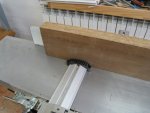Hey Larry - good question and yes, if your technique puts pressure on the infeed side, it can throw off the cut.
Proper jointing technique should have downward pressure, if any at all, on the outfeed side as soon as possible. Also, since you want your pressing (very light, btw, not much at all) near the action on the outfeed side, you will need to use an alternating-hand feed method which makes it real easy to just hop over the guard at the begining of the cut and then just stay there through the rest of it.
Here's how I do it - on any jointer, porkchop or otherwise:
My front (left) hand usually starts about 10" or so from the end of the board before it hits the cutters. My rear (right) hand is about 24" away from my left. If the wood's already dressed and kinda slick, I use a push shoe with an especially sticky pad (sandpaper, mouse pad, neoprene, etc) for my forward force.
After that first ~10" of board is through the cutter head, my right hand is applying all the forward push while my left hand hops over and resumes sharing the load of the forward push.
My right hand stays put until it starts getting close. It's not pushing down much at all, btw. 8-12 inches before my right hand reaches the guard, my left hand lifts and comes back to the business-end of the outfeed table and begins taking over the forward push and my right hand heads back for another 24" bite or so until I reach the end of the board.
At the very end, my right hand leaves the picture and leaves my left hand to finish the cut.
If I put any downward pressure, it's on the outfeed side and not all that much. I don't want the board to flex or that would throw off the jointing. Most importantly, none of my fleshy bits are in a direct line between the force and the cutter head, it's always glancing off.
For example, in the forward pushing of the board with my right hand, if the wood disappears, I'm not pressing down so if it disappears, My right hand only goes sideways and not much downward pressure. I'm not pressing forward near the cutter head, either, so if the wood disappears then, my hands will fly into safe territory no matter what.
That's how I do it, anyway. It certainly takes a little practice to keep from having a varied cut but eventually you do reach a point where the board never stops which is ideal, IMHO









